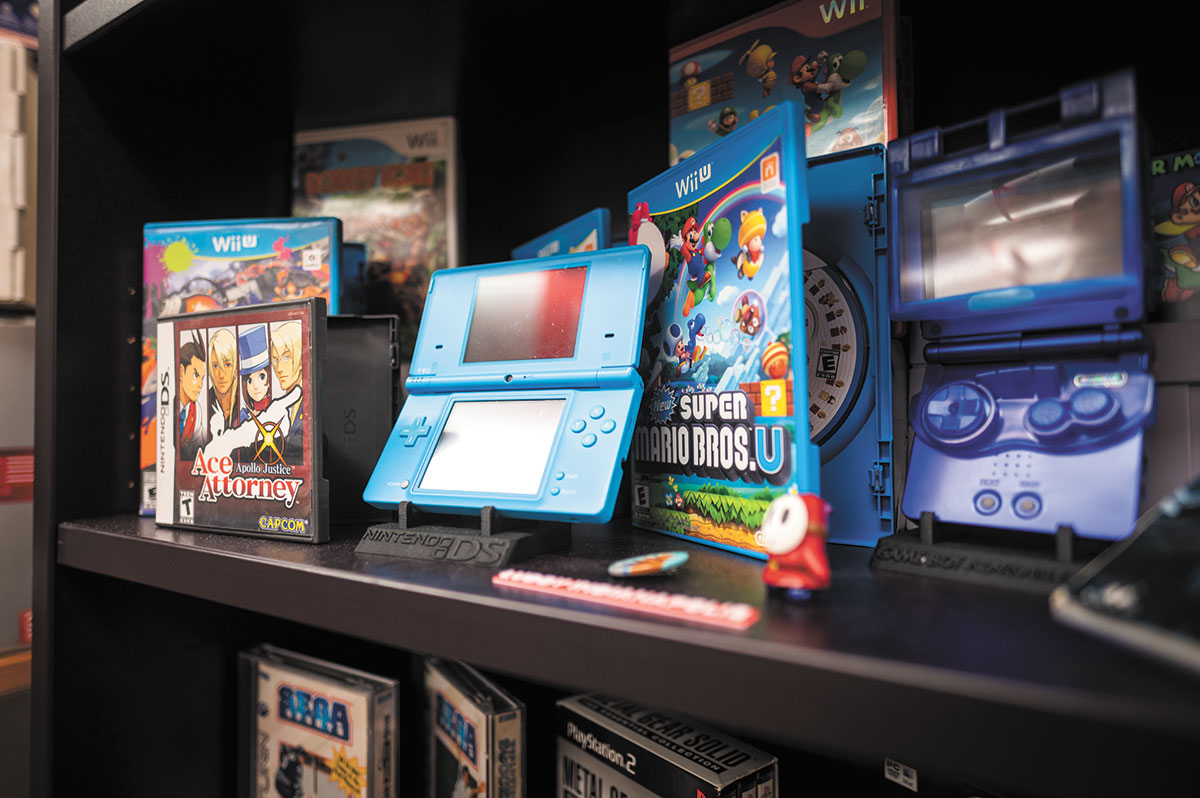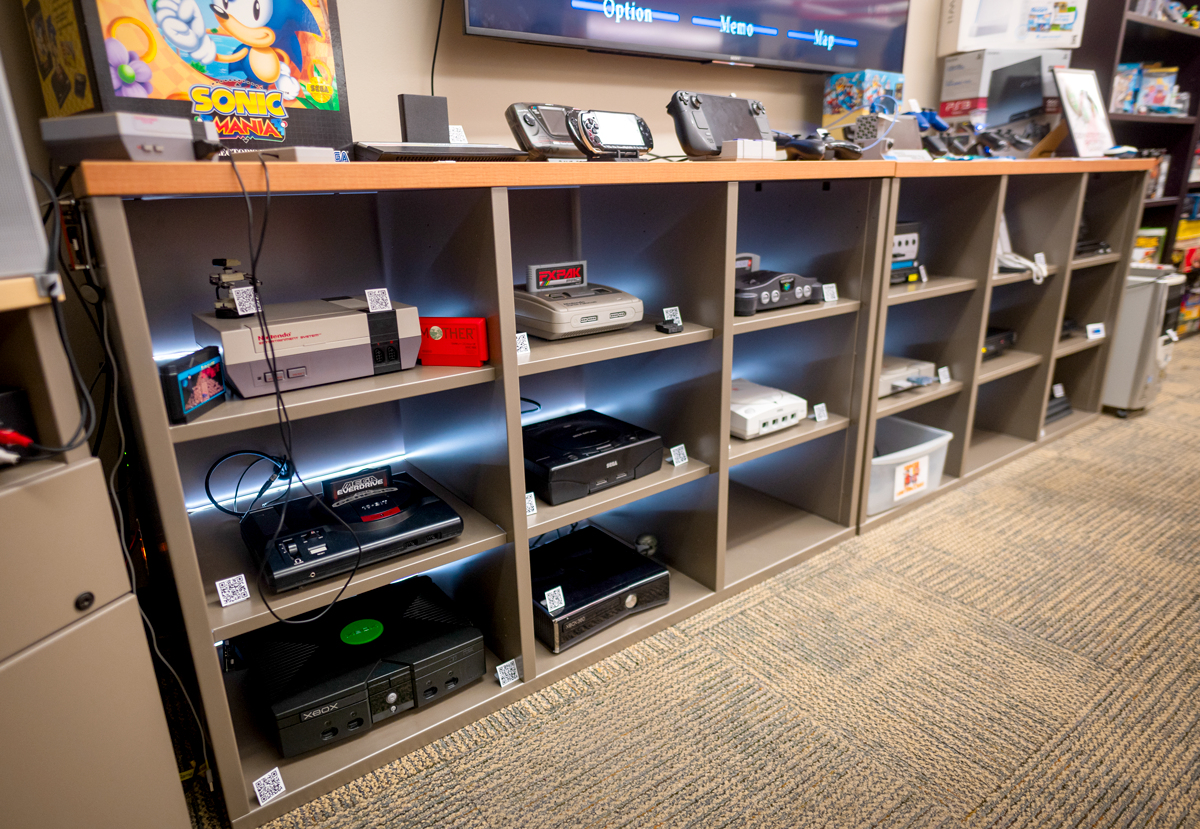Subscriber Benefit
As a subscriber you can listen to articles at work, in the car, or while you work out. Subscribe Now
to save on wear and tear. (Alex Kumar photo, courtesy of Indiana University)
Tucked away in a fourth-floor, 1,000-square-foot back room inside the Informatics and Communications Technology Complex at Indiana University Indianapolis sits an ever-growing collection of some 550 vintage video games and 20 gaming consoles, including such dinosaurs as the Atari 2600 from 1977 and the Commodore VIC-20 from 1980. Although relatively small in scale, the menagerie marks the beginning of what its administrators hope will be part of an international effort to save old games and gaming systems from oblivion.
“People are demanding to see these older games and play them,” said Mathew Powers, media arts and science lecturer. “Public demand is the one thing that’s really helping us move this project forward.”
Powers helped found the Media Arts and Science Research Learning Arcade, or MARLA. Located in the aforementioned back room, it allows enthusiasts to play everything from Sega Genesis to the original Xbox to PlayStations 1 through 4. MARLA’s lineup of “antique” games ranges from the original Sonic the Hedgehog to obscure-but-important Japanese titles and just-plain-obscure promotional items.
“One student brought in a tote full of game cartridges that included video games from McDonald’s Happy Meals that I didn’t even know existed,” Powers said.
He’s spent the last 18 years collecting such items (most donated by IU students) and working with other members of MARLA’s team to both preserve and rehabilitate them.

A boost
This spring, those efforts got a huge boost when the lab’s holdings were designated an IU Museum Collection and given the somewhat whimsical name of the Replayable Object Menagerie collection, or ROM.
But why do video games, a cultural juggernaut that’s enthralled generations of kids for half a century, need saving?
The truth is that while they’ve dominated pop culture and profoundly influenced hundreds of millions of people, the games themselves (whether housed on a cartridge or a CD, or simply floating around on the Internet) have proven surprisingly ephemeral. According to a 2023 study by the Video Game History Foundation, something like 87% of the classic games released in the United States are now no longer available, in any format. This can come as an unpleasant surprise to veteran gamers who want to show off their skills by playing an old-timey title with their kids.
“I know adults who’ve said, ‘I want to show my kids Wing Commander, but I can’t find it anywhere. Where is it?’” Powers said. “I have to tell them that it’s gone. I find that heartbreaking. But that kind of thing really inspired my desire to preserve these games and consoles.”
However, ruining an old gamer’s nostalgia buzz is just one of several unfortunate conundrums created by the preservation problem—or rather, the lack of preservation. Love them or hate them, video games form an important part of late-20th and early-21st century history, and losing them means losing valuable resources for future historians.
Powers and the other MARLA folks aren’t the only gaming experts worried about saving the past.
“Collections such as the one at Indiana University are important for students and faculty to study the history of games, to learn from the past by providing an opportunity to learn from historical games, and to give them an opportunity to learn by playing the games as they were when they were created,” said Andrew Borman, director of digital preservation at The Strong National Museum of Play in Rochester, New York.
Borman became familiar with MARLA this August when Powers and others involved with the program attended a conference at Strong called Save the Games: A Digital Preservation Symposium. Dedicated to the nascent field of video-game conservation, it drew some 200 experts from as far afield as Japan, China, Australia and Europe.
He said that, while private collectors hold vast stockpiles of games and hardware, the number accessible to the general public is quite limited. The Strong museum, with around 70,000 video-game-related artifacts, along with historical documentation from developers, is the most comprehensive public collection. But there’s still lots more to be done.
“Looking at worldwide collections, there are few of any significant size that can be easily accessed,” Borman said. “So it is great to see new initiatives taking shape to provide access in a variety of ways. No one institution, be it IU, the Strong, or others, can possibly do it all.
“As the video game collector market sends prices soaring, collections like these provide an important service, so I am hopeful that other organizations will be inspired by MARLA to start their own initiatives and develop their own spaces for the study of video games,” he added.

Mounting challenges
Preserving video games poses immense challenges. The most obvious is how to keep the old, relatively flimsy, long-discontinued and laughably outdated consoles and game cartridges functional. At MARLA, that task falls largely to staffer Mike Lulgjuraj, who uses a clever workaround to minimize further degradation of the lab’s wares. Instead of slamming in a vintage cartridge to play a particular game, the various consoles available for public use carry internal digital libraries of the games they’re supposed to play, eliminating or mitigating wear and tear.
Unfortunately, keeping MARLA’s collection of antiques running is just one of a rat’s nest of problems. Intellectual property rights complicate efforts to archive older titles, especially when the companies that produced those games are long gone. Their products are typically stuck in legal limbo and are nicknamed “abandonware” by techies.
“We have a bunch of games that just sit here,” Powers said. “Until we can find a way to [legally] work with them, they remain unusable.”
Those legal issues get even thornier with vintage products created by still-very-much-alive entities such as Nintendo. For instance, one thing MARLA (and other game preservation groups) would very much like to do is reconfigure older games whose original consoles are no longer easily available so that they can be played on modern gear. This can even include creating versions of the servers formerly used to host them.
Making a new version of a game that’s not reliant on outdated hardware is called “porting” or “emulation” by fans. But it’s known to lawyers, legions of whom are kept around by Nintendo and other game companies, as piracy. Without clearer legal avenues, preservation groups like MARLA face an uphill battle ensuring that the industry’s history isn’t lost.
“We have to deal with all these legal questions,” Powers said. “How do we prove to [the gaming companies] that we’re not trying to compete with them, and that we’re really trying to preserve what they’ve done?”
Unfortunately for the MARLA folks, the list of preservation threats just keeps growing. In the early days, up through the dawn of the 21st century, games were published in large but manageable numbers. And most were available on some form of physical media—typically cartridges or CDs. Now, games often exist nowhere but on the internet, meaning they could literally pass out of existence forever if, say, a company shut down the server that handles them or simply stopped offering them on the popular online gaming platform Steam.
Even more problematic, there’s been an exponential increase in the sheer volume of new games. That creates even more challenges for curators and archivists stretched thin trying to catalog and save older titles.
“There are so many games that are made every single day,” Powers said. “It’s almost overwhelming to try to preserve this because they’re just throwing them out constantly. It’s like a deluge.”

A donation deluge
Right now, however, dealing with modern online games is seen mostly as a problem for the future. MARLA already has its hands full dealing with a big bump in vintage donations triggered by earning its IU Museum designation.
IU student Haven Hamelin, the MARLA lab tech who sorts and catalogs hardware and software donations, said the floodgates have opened. The University Library VR Lab donated some of its old equipment, including a primitive virtual reality system that requires one to carry along a computer in a backpack. Other recent acquisitions include a Nintendo Switch (handed in when the former owner got a newer model); some obscure, Japan-exclusive games; and old PC games formerly given away in McDonald’s Happy Meals that promoted the Disney movie “Treasure Planet.”
“When I first started getting involved, donors wanted to contribute to the project because this was their specific interest—a space they share with their fellow nerds,” Hamelin said. “But now we’re getting donations from people who just love what we’re doing. They might not even be playing the games. They just want us to have the possibility to give that experience to our current children.”

He predicted that the surge in donations is just starting.
“I would say we’re on the beginning portion of the bell curve,” Hamelin said. “We still have a hill to climb in terms of the growing enthusiasm for this project.”
Powers said he hopes MARLA can become a national leader in video-game preservation. Who knows? It might one day become a real museum, with its own building, where games can be studied and played by future generations. One thing is certain—the public demand for such an institution exists. And for much of the public, the desire to see old games in all their glory is far more visceral than academic.
“I’m 45 years old, and I want to show my own kids the games I grew up on,” Powers said.•
Please enable JavaScript to view this content.

Strange that they have the Japanese Super Famicom on display but not the U.S. SNES.